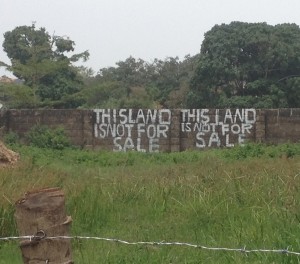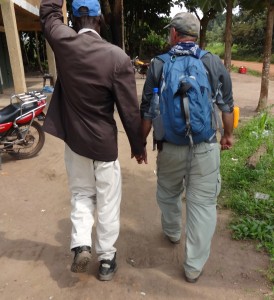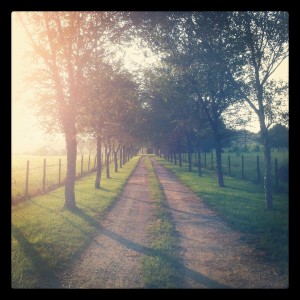
Yesterday’s post concerned the issue of land ownership in Uganda. If you missed it, you can read, “This Land Ain’t for Sale” here.
The story featured in both the podcast (audio) and post (below) is called “The Friendship Lane.” It’s one of my favourites on the art of getting along.
The podcast is a early draft and differs slightly from the print edition.
Enjoy!
Podcast of “The Friendship Lane”:
The Friendship Lane
The most important trip you may take in life is meeting people halfway.
–Henry Boye
I have a question: for what price would you sell your friendship. What amount of money would entice you to turn your back on a neighbor, friend, or family member.
Most of us easily answer, “No amount of money.”
That’s the correct answer but I often wonder if it’s what our actions say.
I’ve seen folks fall out over a family heirloom or perceived slight, I’ve seen a brother and sister fall out for life over a three foot wide strip of inherited land.
This story is about two men who refused to lose their friendship over a difference of opinion. It is a story worth telling. It’s a story worth remembering.
To tell you the story of The Friendship Lane, I must take you there.
So let’s walk together to an overgrown path in the woods. Most people will walk right by this narrow passageway and never notice it, but it always catches my attention because of what it means.
It is located just east of Dry Creek Camp’s property line. It is a ten-foot wide strip between two barbed wire fences.
This path separates the land between the pioneer homesteads of Sereno Hanchey and Lionel Green. These two men, now dead for many years, were descendants of some of the earliest settlers of Dry Creek.
Mr. Rufus Hanchey, Sereno Hanchey’s son, took me to “The Friendship Lane” just before he died.
As we stood there, he related the following story: “Curt, at some point many years ago, there was a difference of opinion between the Hanchey and Green families over where the property line, running east and west, was between our properties. Each family claimed ownership on land that reached over into the other’s present field. Because there was no fence stood as the dividing line, the actual land line was open to dispute.”
Mr. Rufus continued, “My dad and Lionel Green had always been good friends, and they valued their friendship more than any piece of land—and showed it by their subsequent actions. They met at the very spot we are now standing and came up with a solution for this problem. They declared the disputed ten-foot wide strip a “neutral zone.” Each man would build a fence on his respective side of the strip. Together, they agreed on using the strip as a pathway with neither claiming ownership. Due to this arrangement, both families were satisfied and no further problem ever occurred.”

As the son of a land surveyor, I’ve seen some nasty fights between landowners over the difference of a two-foot strip along a fence. Some of the saddest things I’ve ever seen have been the sight of brothers and sisters falling out with each other over inherited land, going to their graves still holding a grudge against a family member. How sad it is when we will let anything, material or temporary, break a priceless relationship with our families or neighbors.
Now, I’m proud of the little plot of land I own. There is something special about walking your field and knowing the mud on your boots is yours.
However, when I feel as if this land really belongs to me, I get out my land abstract.
An abstract is a legal booklet showing the history of ownership of the land you own.
Thumbing through my abstract, I recognize some of the old family names that once lived in this area. It strikes me that some of these once well-known family surnames are no longer found in our area. They are now only names from the distant past. Looking at my abstract, I also notice names of which I have never heard. These prior owners had this land for only a few months or several years.
At this point, the sobering thought materializes: One day the land I live on will belong to someone else. They’ll look at their updated abstract and wonder who the Iles family was that lived here at the beginning of the century.
My visit with Mr. Rufus reminded me that my own land really doesn’t belong to me. He had wisely stated that day during our visit to the woods, “Son, we don’t own this land; it owns us. It really belongs to God. He’s just loaning it to us for this short finite Period of time we call life.”
Standing reverently with Mr. Rufus in the middle of The Friendship Lane, I was so appreciative of his story of these two men who’d placed friendship above an easily forgotten strip of land. People, and the relationships we develop through friendship, are much more important than any land title we can store in a safety deposit box.
The Friendship Lane teaches me another lesson—if we’re going to get along with others, we must give them a little room. Young people today call it “cutting some slack.” If we push against, and rub on others, friction will result. And friction always generates heat, and heat can generate the fire of anger that, in time, harm and can ruin longtime friendships. By simply giving others some space and walking away instead of fighting, the “friendship fences” in our lives can stay mended and in good shape. If we always must “win” by getting our way, we will leave behind a trail of broken relationships, many of them with those closest to us.
I am often reminded of the saying, “You only have so much blood to spill, so choose your battles carefully.”
Darkness is now approaching as I turn and leave Mr. Rufus and the friendship lane behind. Glancing back one last time, I visualize in my mind the long ago scene of Sereno Hanchey and Lionel Green walking their respective fields at sunset. They come upon each other and stop for a visit. Each leans against his own fence, separated by the ten feet of land they share. First one, then the other, crawls through his respective fence. They meet in this grassy neutral area where they shake hands and share a plug of chewing tobacco.
As the sun sets behind the pines, they visit until it is so dark you can barely see them standing there. Only from the sound of their laughter and low voices, can you tell they are standing back there somewhere. They’ve met in the middle of the Friendship Lane.
The richest man in the world is not the one who still has the first dollar
he has ever earned. It is the man who still has his best friends.
 Creekbank Stories Curt Iles, Storyteller
Creekbank Stories Curt Iles, Storyteller


